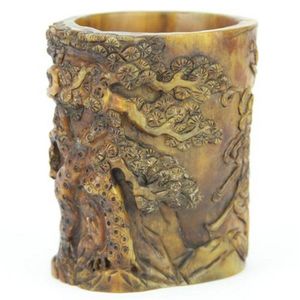Daum Art Nouveau Floral Cameo Glass Vase
A good French Daum Art Nouveau acid etched cameo glass vase, ovoid form, relief etched and enamelled floral designs in yellow/orange and red/brown and with green foliage upon the mottled red/pink, orange and opaque ground. Daum Nancy France signature c.1900. Height 12.3 cm
You must be a subscriber, and be logged in to view price and dealer details.
Subscribe Now to view actual auction price for this item
When you subscribe, you have the option of setting the currency in which to display prices to $Au, $US, $NZ or Stg.
This item has been sold, and the description, image and price are for reference purposes only.
- Oviform /ovoid - The outline loosely resembling the shape of an egg.
- Etched - Glass decorated with an etched design, which is achieved through marking out the pattern, protecting the area that is not be etched, and then immersing the object in acid to dissolve the surface of the unprotected area. With some glass objects, such as cameo glass, there may be several layers of different coloured glass, and part of the top layer is dissolved leaving the bottom layer as the background. The longer the time of exposure of the object to acid, the deeper the etching.
The word etching is also sometimes used to describe another method of decoration, where wheel grinders were used decorate the surface, but this technique is usually known as engraving. - Acid Etched - Acid etching is often used on glass, metals, and stone to create decorative finishes or to prepare the surface for further treatment or coating. The process of acid etching involves applying an acidic solution, such as hydrochloric acid or nitric acid, to the surface of the material and allowing it to react with the surface. The acid etches away a thin layer of the material, creating a rough, uneven finish. Acid etching can be used to create a variety of different finishes, from a subtle matte finish to a more pronounced, textured finish.
- Art Nouveau Period - The Art Nouveau period was a cultural movement that emerged in the late 19th century, and was characterized by its emphasis on natural forms, flowing lines, and a decorative, ornamental style. Art Nouveau was a reaction against the ornate and heavily stylized designs of the previous era, and sought to create a new, more organic aesthetic.
Art Nouveau was characterized by its use of sinuous, curving lines, as well as a focus on natural elements such as flowers, vines, and other organic shapes. Art Nouveau designers sought to create a total work of art, in which every element of a building or object was designed to be harmonious with the overall design.
Some of the most iconic examples of Art Nouveau design include the Paris Metro entrances designed by Hector Guimard, the works of the artist Alphonse Mucha, and the architecture of Victor Horta in Brussels.
The Art Nouveau period was at its peak between 1890 and 1910, but began to decline in popularity by the start of World War I. However, Art Nouveau remains an important influence on design and art to this day, and continues to be celebrated for its emphasis on natural forms and decorative style.
This item has been included into following indexes:
Visually similar items

A Chinese carved soapstone seal, 11 cm high
Sold by
in
for
You can display prices in $Au, $US, $NZ or Stg.

Horn carved brush pot decorated with cherry blossom trees, chrysanthemum & Chinese caligraphy. Condition good, minor age related wear to the base. Height 10 cm
Sold by
in
for
You can display prices in $Au, $US, $NZ or Stg.

Toki fragment - adze poll-end fragment from a large toki. Length 10 cm. Width 6.4 cm
Sold by
in
for
You can display prices in $Au, $US, $NZ or Stg.

Small Melrose Ware vase with applied gum nut and leaf decoration, 12.5 cm tall (faults)
Sold by
in
for
You can display prices in $Au, $US, $NZ or Stg.
